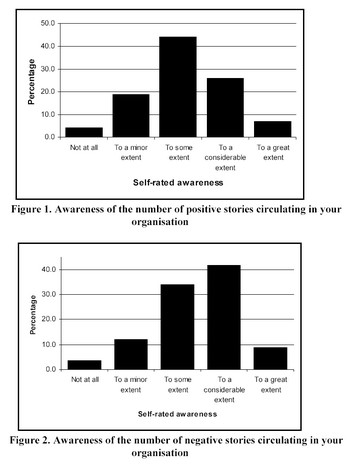Blog
Subscribe
Join over 5,000 people who receive the Anecdotally newsletter—and receive our free ebook Character Trumps Credentials.
Categories
- Anecdotes
- Business storytelling
- Collaboration
- Communication
- Corporate Storytelling
- Culture
- Decision-making
- Employee Engagement
- Events
- Fun
- Insight
- Leadership Posts
- News
- Podcast
- Selling
- Strategy
Archives
- March 2024
- December 2023
- November 2023
- October 2023
- September 2023
- August 2023
- July 2023
- June 2023
- May 2023
- April 2023
Years
What are you more aware of – positive or negative stories?
You may have been part of our Australian wide survey on attitudes and awareness of story and narrative approaches within organisations. One of the questions which we asked was for people to rate their awareness of positive and negative stories in organisational life.
Interestingly, the trend was that people rated that they were generally more aware of negative stories then positive ones with 24.1% of people saying they were aware to a considerable extent to positive stories, as opposed to 41.5% who claimed a similar awareness of negative stories.

I remember hearing Dave Snowden talk about the importance of negative stories and how they have served us. Evolutionarily speaking. The negative story gives us the opportunity to learn from someone’s experience. Often our own. He also mentioned that it is for this reason that negative stories will spread faster through an organisation than positive ones.
Something else which I find interesting about this trend is how powerful an approach like appreciative inquiry might be. If on the whole, most people are less aware of positive stories within their organisation than their negative counter parts, it seems to me that taking an Appreciative Inquiry, seeking out positive stories like those demonstrating “what it’s like when we’re at our best” could surely provide a break through way to how the organisation tackles ‘business as usual’. This may also be at the heart of the usefulness in being a positive deviant.
So, I wonder, what are you more aware of – positive or negative stories?
About Andrew Rixon
Twitter •
Comments
Comments are closed.
Hi Andrew…..
Another great and thought provoking view. Both the positive and the negative stories have their place – it depends on what actions and behaviours one tries to elicit. I agree with you, the Appreciative Inquiry approach is much more interesting and appealing if organisations wish to ‘break through’, rather than fix what’s broken.
The research on positive and negative emotions is relevant here. Negative emotions result in fight, flight, freeze. Positive emotions lead to much broader and creative responses (too much research to dump here, it’s good stuff however!).
Consider also Steve Denning’s work on Storytelling and change – he advocates promoting the positive because he recognises this engages the hearts and minds, and leads to the appropriate positive actions/reactions.
I’d suggest a careful use and balance of both the positive and the negative. Research shows that to achieve ‘break through’ you need more positive than negative. Appreciative Inquiry and Positive Psychology both advocate this.
……Amanda
In “Storytelling in Organisations” Yiannis Gabriel notes that most of the stories he collected were not like the positive, heroic stories generally featured in management literature. They tended to be ambiguous, with both positive & negative elements.
It is important to note that people get bombarded with positive stories from senior management and this generates cynicism. I would challenge that the categories of “positive” & “negative” are helpful. Because it begs the question: positive for whom? But then I am a pessimist by nature…
Hi Matt and Amanda,
Great comments. Thankyou.
Reading between the lines with both your comments seems to be the notion of ‘a balance is important’. This I definitely agree with.
One interesting point. As Matt points out, often senior management will focus on using positive stories, and it often creates cynicism. Argyris’s work also showed this, he called it ‘false positivity’. Interstingly, our survey showed a skew to ages 42+ being more aware of positive stories. (I wont try to draw a conclusion on that stat tho)
I wonder whether this cynicism, and feeling of ‘false positivity’ might stem from the storyteller, not really engaging at an empathetic level with their staff. Maybe this is where a “negative” story can help to provide the empathetic connection which then allows for a more “positive” story to be accepted. Without cynicism.
Andrew – Hmmm. Think you may be onto something. I think “real” stories (which are necessarily a mix of good and bad) build trust.
The other thing with about AI & positive stories is who tells them – i.e. it is those in the organisation telling positive stories not their managers or leaders so much. AI requires a certain humility (and willingness to shut up) on the part of those with power for it to be effective.